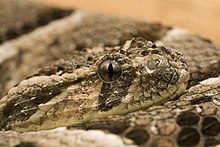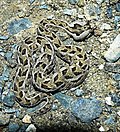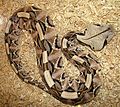
Viperinae, or viperines, are a subfamily of vipers endemic to Europe, Asia and Africa. They are distinguished by their lack of the heat-sensing pit organs that characterize their sister group, the subfamily Crotalinae. Currently, 13 genera are recognized. Most are tropical and subtropical, although one species, Vipera berus, even occurs within the Arctic Circle. Like all vipers, they are venomous.

The Viperidae (vipers) are a family of snakes found in most parts of the world, except for Antarctica, Australia, Hawaii, Madagascar, New Zealand, and various other isolated islands. They are venomous and have long, hinged fangs that permit deep penetration and injection of their venom. Three subfamilies are currently recognized. They are also known as viperids. The name "viper" is derived from the Latin word vipera, -ae, also meaning viper, possibly from vivus ("living") and parere, referring to the trait viviparity common in vipers like most of the species of Boidae.

Acanthophis is a genus of elapid snakes. Commonly called death adders, they are native to Australia, New Guinea and nearby islands, and are among the most venomous snakes in the world. Despite their common name, they are not adders at all and belong to the Elapidae family. The name of the genus derives from the Ancient Greek akanthos/ἄκανθος ('spine') and ophis/ὄφις ('snake'), referring to the spine on the death adder's tail.

Keeled scales refer to reptile scales that, rather than being smooth, have a ridge down the center that may or may not extend to the tip of the scale, making them rough to the touch. According to Street's (1979) description of European lizards and snakes, in those that have keeled scales the keels are usually stronger in male specimens and are consistently arranged according to the species of reptiles, even though many others do not have them. With European lizards, the dorsal scales are usually well keeled, while those on the flanks are more weakly keeled and those on the belly smooth. Non-European lizards such as Sphaerodactylus macrolepis also display keeled scales.

The Gaboon viper, also called the Gaboon adder, is a highly venomous viper species found in the rainforests and savannas of sub-Saharan Africa. Like all other vipers, it is venomous. It is the largest member of the genus Bitis, and it has the longest fangs of any venomous snake – up to 2 inches (5 cm) in length – and the highest venom yield of any snake. No subspecies are recognized.

Bitis nasicornis is a viper species belonging to the genus Bitis, part of a subfamily known as "puff-adders", found in the forests of West and Central Africa. This large viper is known for its striking coloration and prominent nasal "horns". No subspecies are currently recognized. Its common names include butterfly viper, rhinoceros viper, river jack and many more. Like all other vipers, it is venomous.
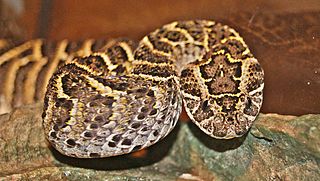
The puff adder is a highly venomous viper species found in savannahs and grasslands from Morocco and western Arabia throughout Africa except for the Sahara and rainforest regions. It is responsible for causing the most snakebite fatalities in Africa owing to various factors, such as its wide distribution, frequent occurrence in highly populated regions, and aggressive disposition. Like all other vipers, it is venomous. Two subspecies are currently recognized, including the nominate subspecies described here.

Hypnale is a genus of venomous pit vipers endemic to Sri Lanka and southwestern India. Three monotypic species are currently recognized. All members have more or less upturned snouts that produce a hump-nosed effect.

Trimeresurus albolabris, the white-lipped pit viper or white-lipped tree viper, is a venomous pit viper species endemic to Southeast Asia.

Causus is a genus of vipers found only in sub-Saharan Africa. It is a group considered to be among the most primitive members of the family Viperidae based on head scalation, oviparity, venom apparatus, and because they have round pupils. However, this is contradicted by recent molecular studies. Seven species are currently recognized. They are commonly known as night adders. Like all other vipers, they are venomous.
Bitis arietans somalica also known as the Somali puff adder, is a venomous viper subspecies found only in Somalia, eastern Ethiopia, and northern Kenya. It is distinguished from B. a. arietans by its keeled subcaudals.

The berg adder is a venomous viper species endemic to mountainous regions in southern Africa. No subspecies are currently recognized.

The horned adder is a viper species. It is found in the arid region of southwest Africa, in Angola, Botswana, Namibia; South Africa, and Zimbabwe. It is easily distinguished by the presence of a single, large horn-like scale over each eye. No subspecies are currently recognized. Like all other vipers, it is venomous.
The Albany adder is a viper species. It was previously considered a subspecies of Bitis cornuta. Its range is restricted to eastern and southern Cape Province in South Africa. Like all vipers, it is venomous.
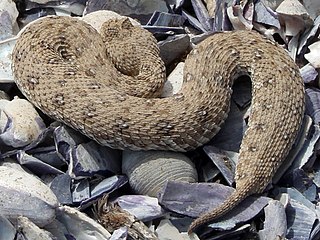
Bitis schneideri is a species of venomous snake in the subfamily Viperinae of the family Viperidae. The species is native to a small coastal region that straddles the border between Namibia and South Africa. B. schneideri is the smallest species in the genus Bitis and possibly the world's smallest viper. There are no subspecies that are currently recognized as being valid.

Bitis parviocula is a venomous viper species found only in Ethiopia. It is large with a broad head and spectacular geometric markings. In 1995, the species was known from only three specimens, but additional information has surfaced since then. Little is known about its natural history or its venom. No subspecies are currently recognized.
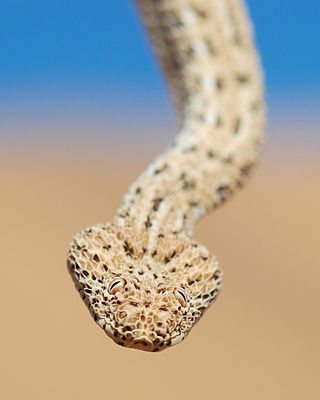
Bitis peringueyi, also known as the Peringuey's adder, Peringuey's desert adder or desert sidewinding adder, is a venomous viper species found in Namibia and southern Angola. No subspecies are currently recognized.

Bitis rhinoceros is a viper species endemic to West Africa. Like all vipers, it is venomous. It can be easily distinguished from the closely related species B. gabonica by the presence of two large nasal "horns".
